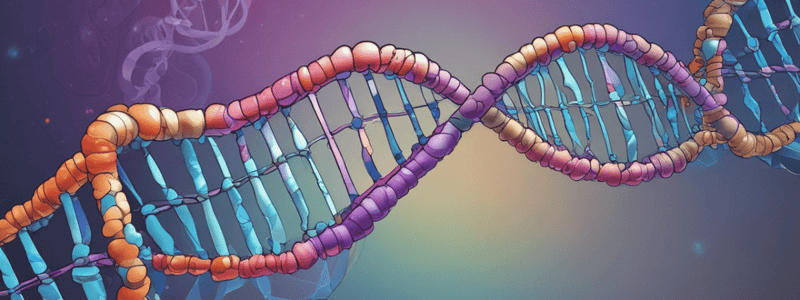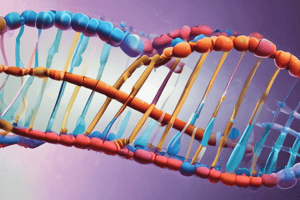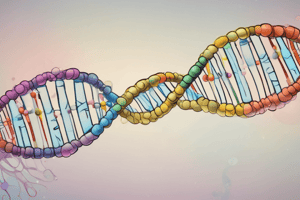Podcast
Questions and Answers
What is the role of reverse transcriptase in the replication of RNA viruses that replicate their RNA via a DNA intermediate?
What is the role of reverse transcriptase in the replication of RNA viruses that replicate their RNA via a DNA intermediate?
It transcribes the RNA template into a complementary cDNA strand to form a DNA:RNA hybrid and has three enzyme activities: RNA-directed DNA polymerase, RNase H, and DNA-directed DNA polymerase.
What is the function of the primer in the reverse transcription process?
What is the function of the primer in the reverse transcription process?
The primer is a specific tRNA molecule captured from the host cell that initiates the synthesis of cDNA.
How does the RNase H activity of reverse transcriptase contribute to the replication of RNA viruses?
How does the RNase H activity of reverse transcriptase contribute to the replication of RNA viruses?
It degrades the RNA chain in DNA:RNA hybrids, allowing the completion of DNA synthesis.
What is the final product of the reverse transcription process in retroviruses?
What is the final product of the reverse transcription process in retroviruses?
What is the difference between RNA-directed DNA polymerase and DNA-directed DNA polymerase activities of reverse transcriptase?
What is the difference between RNA-directed DNA polymerase and DNA-directed DNA polymerase activities of reverse transcriptase?
How do retroviruses replicate their RNA genome?
How do retroviruses replicate their RNA genome?
What is the role of the tRNA primer in the initiation of DNA synthesis during reverse transcription?
What is the role of the tRNA primer in the initiation of DNA synthesis during reverse transcription?
What are the three enzyme activities of reverse transcriptase?
What are the three enzyme activities of reverse transcriptase?
What is the function of the DNA-directed DNA polymerase activity of reverse transcriptase?
What is the function of the DNA-directed DNA polymerase activity of reverse transcriptase?
Why are RNA viruses that replicate their RNA via a DNA intermediate termed retroviruses?
Why are RNA viruses that replicate their RNA via a DNA intermediate termed retroviruses?
What is the significance of the DNA:RNA hybrid formed during reverse transcription?
What is the significance of the DNA:RNA hybrid formed during reverse transcription?
How does the RNA-directed DNA polymerase activity of reverse transcriptase contribute to the generation of protein diversity?
How does the RNA-directed DNA polymerase activity of reverse transcriptase contribute to the generation of protein diversity?
What is the role of the host cell in the replication of RNA viruses?
What is the role of the host cell in the replication of RNA viruses?
How does the RNase H activity of reverse transcriptase contribute to the formation of a DNA duplex?
How does the RNase H activity of reverse transcriptase contribute to the formation of a DNA duplex?
What is the significance of the DNA duplex formed during reverse transcription?
What is the significance of the DNA duplex formed during reverse transcription?
How does reverse transcription allow for the generation of genetic diversity in RNA viruses?
How does reverse transcription allow for the generation of genetic diversity in RNA viruses?
What is the advantage of using a DNA intermediate in the replication of RNA viruses?
What is the advantage of using a DNA intermediate in the replication of RNA viruses?
How does the replication of RNA viruses that use a DNA intermediate differ from those that do not?
How does the replication of RNA viruses that use a DNA intermediate differ from those that do not?
What is the significance of the reverse transcription process in the life cycle of RNA viruses?
What is the significance of the reverse transcription process in the life cycle of RNA viruses?
How does the primer for reverse transcriptase contribute to the specificity of DNA synthesis?
How does the primer for reverse transcriptase contribute to the specificity of DNA synthesis?
What is the significance of using a specific tRNA molecule as a primer in the initiation of DNA synthesis during reverse transcription?
What is the significance of using a specific tRNA molecule as a primer in the initiation of DNA synthesis during reverse transcription?
How does the RNA-directed DNA polymerase activity of reverse transcriptase contribute to the formation of a DNA:RNA hybrid?
How does the RNA-directed DNA polymerase activity of reverse transcriptase contribute to the formation of a DNA:RNA hybrid?
What is the role of the DNA-directed DNA polymerase activity of reverse transcriptase in the replication of RNA viruses?
What is the role of the DNA-directed DNA polymerase activity of reverse transcriptase in the replication of RNA viruses?
Why do RNA viruses that replicate their RNA via a DNA intermediate require a unique enzyme, reverse transcriptase?
Why do RNA viruses that replicate their RNA via a DNA intermediate require a unique enzyme, reverse transcriptase?
What is the advantage of having a DNA intermediate in the replication of RNA viruses?
What is the advantage of having a DNA intermediate in the replication of RNA viruses?
How does the RNase H activity of reverse transcriptase contribute to the degradation of the viral genome during reverse transcription?
How does the RNase H activity of reverse transcriptase contribute to the degradation of the viral genome during reverse transcription?
What is the significance of the specific base pairing postulated by Watson and Crick in the context of DNA replication?
What is the significance of the specific base pairing postulated by Watson and Crick in the context of DNA replication?
What is the difference between unidirectional and bidirectional DNA replication?
What is the difference between unidirectional and bidirectional DNA replication?
What is the role of DNA helicases and gyrases in DNA replication?
What is the role of DNA helicases and gyrases in DNA replication?
What is the difference between the leading strand and the lagging strand in DNA replication?
What is the difference between the leading strand and the lagging strand in DNA replication?
What is the significance of the semidiscontinuous model of DNA replication?
What is the significance of the semidiscontinuous model of DNA replication?
What is the characteristic of DNA replication that makes it 'semiconservative'?
What is the characteristic of DNA replication that makes it 'semiconservative'?
What is the reason why AZT and 3TC inhibit the replication of HIV?
What is the reason why AZT and 3TC inhibit the replication of HIV?
Why is it difficult to devise an effective vaccine against HIV?
Why is it difficult to devise an effective vaccine against HIV?
What is the function of phosphorylation in the in vitro and in vivo processes of AZT and 3TC?
What is the function of phosphorylation in the in vitro and in vivo processes of AZT and 3TC?
How do AZT and 3TC get incorporated into growing DNA chains?
How do AZT and 3TC get incorporated into growing DNA chains?
What is the significance of the structure of AZT and 3TC in inhibiting HIV replication?
What is the significance of the structure of AZT and 3TC in inhibiting HIV replication?
What is the consequence of incorporating AZT and 3TC into growing DNA chains?
What is the consequence of incorporating AZT and 3TC into growing DNA chains?
What is the significance of nicks at W and E in the context of recombinant heteroduplexes?
What is the significance of nicks at W and E in the context of recombinant heteroduplexes?
What is the major discovery made by Barbara McClintock in the 1950s?
What is the major discovery made by Barbara McClintock in the 1950s?
What is the purpose of genetic recombination as it relates to generating protein diversity?
What is the purpose of genetic recombination as it relates to generating protein diversity?
How are the ends of chromosomes replicated?
How are the ends of chromosomes replicated?
What is the primary function of DNA polymerases?
What is the primary function of DNA polymerases?
What is the role of DNA repair mechanisms in maintaining genome stability?
What is the role of DNA repair mechanisms in maintaining genome stability?
What is the process called when genetic information is rearranged to create new associations?
What is the process called when genetic information is rearranged to create new associations?
What is the term for the enzymatic insertion of a transposon, a mobile segment of DNA?
What is the term for the enzymatic insertion of a transposon, a mobile segment of DNA?
What is the experiment that demonstrated the exchange of DNA segments during recombination?
What is the experiment that demonstrated the exchange of DNA segments during recombination?
What is the process that requires the breakage and reunion of DNA strands?
What is the process that requires the breakage and reunion of DNA strands?
What type of recombination involves similar DNA sequences?
What type of recombination involves similar DNA sequences?
What is the term for recombination involving very different nucleotide sequences?
What is the term for recombination involving very different nucleotide sequences?
What is the significance of the semiconservative model of DNA replication in the context of genetic information transmission?
What is the significance of the semiconservative model of DNA replication in the context of genetic information transmission?
How does the bidirectional replication mechanism overcome the problem of supercoiling during DNA replication?
How does the bidirectional replication mechanism overcome the problem of supercoiling during DNA replication?
What is the role of Okazaki fragments in the semidiscontinuous model of DNA replication?
What is the role of Okazaki fragments in the semidiscontinuous model of DNA replication?
What is the significance of the specific base pairing postulated by Watson and Crick in the context of DNA replication?
What is the significance of the specific base pairing postulated by Watson and Crick in the context of DNA replication?
How does the process of DNA replication ensure the accuracy of genetic information transmission?
How does the process of DNA replication ensure the accuracy of genetic information transmission?
What is the consequence of the discontinuous synthesis of DNA on the lagging strand during DNA replication?
What is the consequence of the discontinuous synthesis of DNA on the lagging strand during DNA replication?
What is the significance of reverse transcriptase in the replication of RNA viruses that use a DNA intermediate?
What is the significance of reverse transcriptase in the replication of RNA viruses that use a DNA intermediate?
How does the RNase H activity of reverse transcriptase contribute to the replication of RNA viruses?
How does the RNase H activity of reverse transcriptase contribute to the replication of RNA viruses?
What is the role of the specific tRNA molecule used as a primer in the initiation of DNA synthesis during reverse transcription?
What is the role of the specific tRNA molecule used as a primer in the initiation of DNA synthesis during reverse transcription?
What is the significance of the DNA duplex formed during reverse transcription?
What is the significance of the DNA duplex formed during reverse transcription?
How does the DNA-directed DNA polymerase activity of reverse transcriptase contribute to the replication of RNA viruses?
How does the DNA-directed DNA polymerase activity of reverse transcriptase contribute to the replication of RNA viruses?
What is the significance of nicks at N and S in the context of recombinant heteroduplexes?
What is the significance of nicks at N and S in the context of recombinant heteroduplexes?
What is the significance of the RNA-directed DNA polymerase activity of reverse transcriptase in the replication of RNA viruses?
What is the significance of the RNA-directed DNA polymerase activity of reverse transcriptase in the replication of RNA viruses?
How do transposons contribute to genetic recombination?
How do transposons contribute to genetic recombination?
What is the role of genetic recombination in generating protein diversity?
What is the role of genetic recombination in generating protein diversity?
What is the process by which genetic information is rearranged to create new associations?
What is the process by which genetic information is rearranged to create new associations?
What is the significance of Barbara McClintock's 'jumping genes' model?
What is the significance of Barbara McClintock's 'jumping genes' model?
What is the result of nicks at W and E in the context of recombinant heteroduplexes?
What is the result of nicks at W and E in the context of recombinant heteroduplexes?
What is the underlying process that involves the breakage and reunion of DNA strands, leading to the shuffling of genetic information?
What is the underlying process that involves the breakage and reunion of DNA strands, leading to the shuffling of genetic information?
What type of recombination involves similar DNA sequences, leading to the exchange of genetic material?
What type of recombination involves similar DNA sequences, leading to the exchange of genetic material?
What is the term for the enzymatic insertion of a transposon, a mobile segment of DNA, into a new location?
What is the term for the enzymatic insertion of a transposon, a mobile segment of DNA, into a new location?
What is the process called when genetic information is rearranged to create new associations, such as during homologous recombination?
What is the process called when genetic information is rearranged to create new associations, such as during homologous recombination?
What is the experiment that demonstrated the exchange of DNA segments during recombination, involving 'heavy' and 'light' phage?
What is the experiment that demonstrated the exchange of DNA segments during recombination, involving 'heavy' and 'light' phage?
What type of recombination involves very different nucleotide sequences, leading to the creation of new genetic combinations?
What type of recombination involves very different nucleotide sequences, leading to the creation of new genetic combinations?
How does the incorporation of AZT and 3TC into growing DNA chains affect HIV replication?
How does the incorporation of AZT and 3TC into growing DNA chains affect HIV replication?
What is the significance of the high error rate of HIV reverse transcriptase?
What is the significance of the high error rate of HIV reverse transcriptase?
How do nucleoside analogs like AZT and 3TC work as HIV reverse transcriptase inhibitors?
How do nucleoside analogs like AZT and 3TC work as HIV reverse transcriptase inhibitors?
What is the role of phosphorylation in the in vitro and in vivo processes of AZT and 3TC?
What is the role of phosphorylation in the in vitro and in vivo processes of AZT and 3TC?
What is the significance of the structure of AZT and 3TC in inhibiting HIV replication?
What is the significance of the structure of AZT and 3TC in inhibiting HIV replication?
How do HIV reverse transcriptase inhibitors like AZT and 3TC affect the life cycle of HIV?
How do HIV reverse transcriptase inhibitors like AZT and 3TC affect the life cycle of HIV?
Flashcards are hidden until you start studying




